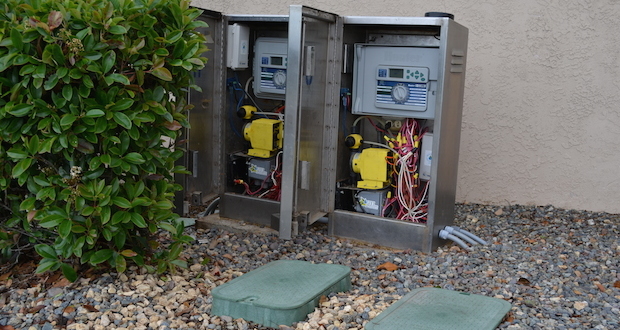An overview of fertilizing through irrigation systems
By Robert Garcia

Fertigation combines fertilizers with an irrigation system to deliver nutrients to plant material in an efficient, systematic manner. This process, which can be more economical than traditional methods, allows an existing irrigation system to fertilize a landscape evenly and without waste, giving soil, plants and turf the nutrients they require.
Benefits of fertigation
Fertigation systems are easy to use and the process requires less labor than traditional fertilizing methods. When using a granular fertilizer, for example, it is necessary to carry 50-pound bags to and from a site and use push spreaders to distribute the fertilizer. After its application, extra watering is required to dissolve the granular fertilizer. Then excess fertilizer needs to be cleared from sidewalks and other non-plant areas.
Components of a fertigation system
Fertigation systems can be used residentially, commercially and on sports fields. As such, they vary in sizes. Fertigation systems are made up of tanks that store liquid fertilizer, and injectors that infuse fertilizer into the main water supply through a pressure-controlled valve. These systems can be used on all irrigation methods including spray heads, rotors and drip irrigation systems. They can also be used to apply other chemicals, such as pre-emergent, insecticides, herbicides and growth regulators. This practice is often referred to as chemigation.
Timing and usage
A fertigation system can be on the same timer as an irrigation system, which typically runs during the night. Or it can be controlled by hand using a mobile fertigation system. This method is used to treat only designated areas within a landscape.
Type of water and fertilizer
Fertigation can be used on systems utilizing either type of water, but it is recommended to work with your liquid fertilizer provider if you are using non-potable water. The correct fertilizer mix will be determined based on type of water and what you are fertilizing. It also depends on what you are trying to accomplish. For example, to quickly boost turf, a heavy nitrogen mix is recommended. The type of fertilizer will depend on the time of year, whether it is a growing or dormant period.
Drawbacks of fertigation
Potential problems of fertigation are similar to issues that occur when using traditional fertilizing methods: the wrong fertilizer or amount is utilized and the affected plant material is damaged. Liquid fertilizers tend to be pre-diluted with water, so you will have to use more of a liquid fertilizer during fertigation than you would for a water-soluble fertilizer that distributes across the landscape with a spreader. This means that the cost of fertilizer may be higher than using a traditional, water-soluble method.
Robert Garcia is South County operations manager for Heaviland Landscape Management, a full-service commercial landscape maintenance, installation and resource management company based in Vista, Calif. A Landscape Industry Certified technician in ornamental maintenance, Garcia is certified as a recycled water site supervisor through the San Diego County Water Authority. He manages two of Heaviland Landscape Management’s largest accounts in the City of Poway and Poway Business Park, both located in Poway, Calif.


